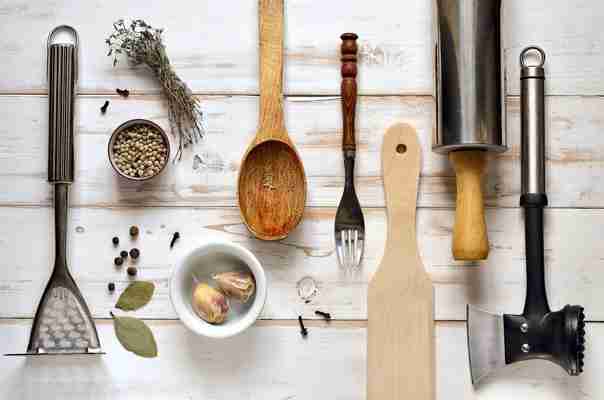Get to know all the many different types of kitchen utensils so you can be sure to use only the right cooking tool whether you're making a soup, a steak, a casserole, or a dessert.

Last updated on February 18th, 2022 at 03:46 pm
Working in a kitchen, whether a home or professionally, requires a good number of tools that need to be present and handy. Moving from soup to steak to a casserole and then a dessert can easily involve a dozen different tools. So a well-prepared kitchen is going to have a good stock of utensils ready to go for what a recipe demands.
We’ve all seen and grown up with some version of the kitchen spoon. This is an oversized spoon instrument useful for working food and liquids in big pots. It’s an essential do-all tool in terms of scooping, moving, stirring, and holding food in place while working on it. The kitchen spoon has been around for centuries, and ancient cultures made them frequently from wood and sometimes from metal, such as copper. The Kitchen Spoon comes in two forms, solid and slotted. The slotted spoon gives a user the added advantage of draining liquid from underneath while controlling solid foods captured in the basin of the spoon. At a minimum, the tool is great for checking the status of food, avoiding burning one’s hands doing the same, and avoiding contamination.
Related: How to store more utensils
This big spoon is curved or designed with a long stick handle and a very big, cup-like spoon basin at the end. The handles sometimes have a curve or hook on the end for hanging or for making sure the ladle doesn’t slip inside large pots while cooking or server. The Soup Ladle is ideal for removing soup and stews from larger pots to smaller ones or for serving individual bowls. Again, this instrument has been around for centuries, and some of the best versions to work with today are stainless steel.
This spoon looks very much like other soup spoons except for two big differences – an edge with teeth and a hole in the middle of the basin. The teeth allow you to grab pasta in hot water quickly and the hole allows the water to drain out. You end up with the pasta without the mess when pulling the food out of a hot boiling pot. It’s ideal for serving pasta from the main cooking container.
Have you ever tried to scoop ice cream out with a regular spoon? It’s not really ideal and you may end up bending the spoon. The Ice Cream Scooper gives you better leverage with a stronger handle and deep-curved spoon that allows the ice cream to curl up for that perfect dessert ball served in a bowl. The Scooper typically comes in two forms, static basic design and one with a separator function. The separator function makes it easy to remove the ice cream from the spoon once scooped with a thumb actuator that slices the ice cream from the spoon surface. Either works fine, but the separator version works faster when serving a lot of ice cream at once.
It’s not really a spoon, but the spatula is a close cousin… although there are several types of spatulas. The omelette spatula is an example of one type of spatula. Flat in nature, this tool allows you to slide under food and pick it up to serve from a hot skillet or to flip to cook the other side. It also doubles as a quick blunt knife on food cooking as well as a stirrer, but it doesn’t work wonderfully well in these secondary roles. Spatulas typically come in large sizes and sometimes slotted, but cooks find having two versions, one large and one small work best in a busy kitchen. For smaller dishes and frying pans, the large spatula becomes overkill but the smaller size is ideal.
See more types of spoons here.
Sizable and sharp, the Basic Kitchen Knife comes in either a half foot blade or larger. It’s ideal for cutting large and medium-sized food pieces that need to be diced, sliced or separated apart. This is a standard kitchen tool in any working kitchen, and many professional cooks have their own special blade to work with versus generic brands. It is the do-all cutter for any cook and a basic essential.
A small knife with a blade about the size of a finger, this tool is great for cutting small pieces of food, singular piece removals, paring fruit, gouging, or cutting minute parts off. It doesn’t do well in larger food portions, but the paring knife is ideal for delicate cutting work.
One will notice the difference on this blade due to the serrated edge. Unlike most kitchen knives that have a smooth cutting edge, the bread knife looks rough and vicious. This serration is critical to cut through bread quickly like a saw instead of separating it apart. Trying to cut bread with a solid blade often causes the bread to squish instead of separate unless the blade is extremely sharp. The serrated edge solved this problem.
With a far less pronounced serration than a bread knife and longer blade, the Serrated Knife is ideal for cutting through large pieces of meat quickly, especially when it has been a cook. The serration allows a sawing action to effect the cut, something that is not possible with a regular blade. Folks will often see this type of blade used when cutting large roasts, turkey, chicken slides and more.
With a long thin blade, this tool is ideal for separating meat from bone such as in fish. It cuts with a regular blade, but the thinner design allows the cook to poke into the food to effectuate a cut better. This tool can also be used to size special meat cuts such as filets.
Most knife kits will have one but they can be bought separately. The Knife Sharpener looks like a long metal rod with a handle. However, if you feel the surface of the rod, it will be rough. The kitchen knife is worked against this surface in a cutting, friction fashion, which in turn resharpens the edge of the blade. Cooks use this tool regularly to keep their blades in top shape, but folks also need to watch out because sharp edges cut through fingertips and hands extremely fast before one realizes what happened. Sometimes a blunt knife with pressure is just a safer, period.
See all kitchen knives here as well as our review of Craftstone knives.
Sure, any pair of scissors can be used to cut things apart, but Kitchen Scissors are designed to be a bit more robust, for cutting through thinks like branches, sinew, bone, tendon, and harder parts of food quickly. Having a pair adds to your ability to prepare food faster, smarter and more efficiently.
Learn more about the different types of scissors here.
The last place you want to be cutting food is your counter surface. A Cutting Board is designed to take a beating, provide a safe place to cut or work on food, and then can be washed off quickly. It’s highly recommended to use a plastic board versus wood as wood boards tend to absorb food juices which can then be a breeding ground for bacteria. With plastic, the board cleans easier, nothing penetrates, and the bacteria can’t get a foothold inside the board surface.
Discover all the different types of cutting boards here.
Sometimes a cook just needs to use brute force. A good kitchen mallet today is made of aluminum, comes with a flat side and then a bumped or pointed side. The flat side is essentially for hammering food, usually frozen, to break it apart or soften it. The pointed or bumped side is a tenderizer feature, often used on meats to soften them with bruising, which in turn allows juices and marinades to penetrate the meat easier prior to cooking.
Let’s face it, nuts are a pain. A nutcracker makes short work of the shell, allowing you to get to the inside quickly. It’s often a go-to tool for baking when you want to use walnuts or similar for ingredients and toppings.
You could spend a lot of time finely sliced garlic cloves, our you could just place a clove in a Garlic Press and squeeze out the innards into your food or mix quickly. Brute force refined into a small tool can do some amazing things fast.
This tool comes in either small or large side, with regular metal or with covered ends. In any form, tongs are great for grabbing food, particularly when hot and moving it around. Tongs are a basic tool when BBQ’ing or working on flame, allowing the cook to flip food, move it around, place or remove it for serving and doing all that activity without burning one’s hands. Tongs also help avoid contamination by keep hands out of food in the cooking process. Consider them an extension of your fingers in the kitchen once the food is either cooking or is being served.
During the war years, if someone got in trouble in the army, he would find himself stuck in a room piled high with potatoes and be given a bucket and a peeler tool, spending days on end skinning potatoes for cooking, or so the cartoons would go. The peeler still shows up today, essential for taking the outer skin off vegetables in a safe, quick manner.
Some are very simple metal instruments and others come with ergonomic handles. If you prepare vegetables a lot with skin removal, then a peeler is going to need to be in your kitchen toolbox. It actually provides two functions: the peeling which is obvious from the long blade element, and the pointed edge tip which allows one to gouge out potatoes’ eyes and vegetable spot blemishes. Peelers also come in a flat version for the removal of larger widths of food as needed.
Click here to learn about the different types of peelers.
Whether it be cheese shredding or lemon peel curling, a serrated scraper allows a cook to quickly reduce a large piece of prep food into much smaller pieces for using cooking. The Steel Grater comes in either a board-form with a handle or a box shape with multiple serration forms on each of the four sides. This is a basic food prep tool that reduces large food to small size very quickly and safely instead of trying to do the same with a knife.
It looks like an alien communication antenna but the whisk is a soup or liquid manual mixer. When you just need to give things a quick stir, manually mix, or make sure the consistency of a soup or sauce is preparing right, the whisk is the best way to go. An automated mixer is often an overkill. The whisk comes in small or larger sizes and allows for quick swirling mixing to get the job done fast. It’s ideal, for example, for beating eggs to prepare them for baking or cooking without getting your hands messy in the process. Whisks come in different forms but the tell-tale sign is the spiral or multi-wire end which is used to mix the food.
Whether it be the very old-style peeler or the modern turn-screw style, the can opener is a must if you’re using any kind of preserved food stored in a manufactured food can. Today, manufacturers have made it easier for consumer cans to be open with a built-in pull tab, but most stock food in larger cans still needs a bona fide can opener to access the food inside. The best version to get is the screw turn type which simply latches onto the edge of the can. As the user turns the screw, the opener moves along the edge of the can separating the lid until it can be bent back and removed. Hint – get a version with robust handle grips. It works faster and is far more comfortable than the bare metal cheap version of the tool.
What you might not know is that there are many different types of can openers to choose from.
When you look at this tool you might think it’s a waffle press or something similar. Instead, the potato masher is designed to squish and mush vegetable food so that it can be served in, you guessed, mashed format. Ideal for cooked potatoes and quick prepping into mash potatoes form, this tool also works well on other soft foods that need to be combined together quickly in a bowl.
The problem with large meats being cooked, turkeys and hams, is that they have a tendency to dry out. When meat cooks, it lets go of its moisture and grease. This drains to the bottom of the pan. The meat gets hot and becomes what we are familiar with when we eat, but if it dries out too much then the food becomes hard to eat, more like chewing leather. So, the baster allows a cook to literally suction up the water and grease mid-cooking from the bottom of the pan and put it back on the top of the meat to re-moisten it. The process makes a huge difference in the outcome. The baster is also good for sucking up the remaining juice after the meat is removed and making a complimentary gravy from it.
If you ever have flat food that needs to be cut into smaller parts, like a pizza, for example, it’s extremely hard to do with a regular knife. But with a pizza cutter, you just roll along the cutting line and the Pizza Cutter edge does the work via pressure.
If you serve a lot of fruit, cutting it into pieces can be tedious and unsafe for your fingers. The Apple Slicer makes the job easier cutting the fruit into multiple pieces and quickly separating the core. It works for most fruits you can position standing on a cutting board. Then you take the Slicer, press down on the fruit with it, and the tool separates the parts quickly.
Getting real fruit juice or lemon squeeze can be a hassle and messy doing it by hand. The Squeezer allows you to take a fruit half, press down and twist on the squeezer, and out drains the juice on the bottom of the tray. You then remove the fruit and pour the juice into a cup or container without the mess.
Not many home kitchens or professional outfits use it very much anymore, but the mortar and pestle is a great tool for grinding food into small powders and dry consistencies quickly. Using pressure and friction, the mortar acts as a bowl while the pestle held by the hand mashes the food into powder form fast. This is a great tool for breaking down larger, hard foods into small parts.
If you do a lot of recipes and baking, then you need a set of measuring cups. These come in small to large sizes with the exact measurement size and containment in each. For folks who want to follow recipes exactly, these cups are a must in baking and cooking.
Try to use a regular brush in cooking and you may find the bristles separating or melting off. With a Cooking Brush, you use a specially prepared brush that can baste or paint sauces, liquids and similar to foods safely. A common use of a Cooking Brush is in the application of sauces on BBQ food or roasts.
If you’re going to do a lot of baking, then you need some way to flatten dough quickly. The rolling pin has been around for centuries as the essential baking tool for flattening food. It’s also a really good tool for chasing people out of the kitchen when they’re trying to sneak food early.
We also wrote about 6 rolling pin alternatives here.
Ever watch those 2 am infomercials featuring what looks like the greatest kitchen slicer gadget ever? I have. I’ve bought them. I usually watch the infomercial then a month later I’ll be in some department store and see something similar. They’re usually fairly cheap and I’ll remember just how amazing the thing was and buy it only to use it once.
But once in a while, usually for making a big salad, that sucker comes in handy… assuming I don’t end up slicing a tip of a finger off. These things can be deadly. The blades are wicked sharp and you use them at lightning speed not paying attention and then slice.
When you need garlic chopped into tiny pieces, you use a garlic press.
I actually prefer slicing and dicing with a good kitchen knife but I see the appeal of a garlic press.
Not sure what to get – buy a kitchen tool set
Make it easy on yourself and just buy a full set like the one above. I’m a big fan of sets because it’s easy. Instead of hurting your brain with each individual purchase, get a mid-priced or high-priced set which will likely cost less for everything than if you buy it individually.
Related: 7 Different Types of Cheese Graters | 22 Types of Cookware Options for Your Kitchen (Pots and Pans) | 15 Different Types of Food Slicers | 10 Different Types Of Frying Pans | 25 Different Types of Sauce Pans | 31 Different Types of Deep Fryers | All the types of kitchen cookware | Bakeware buying guide | 10 overrated kitchen appliances












